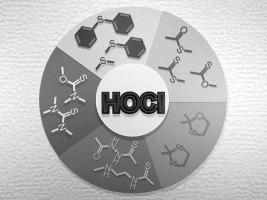Coordination Chemistry Reviews ( IF 20.3 ) Pub Date : 2021-10-07 , DOI: 10.1016/j.ccr.2021.214232 Ji-Ting Hou 1, 2 , Nahyun Kwon 3 , Shan Wang 2 , Bingya Wang 2 , Xiaojun He 1 , Juyoung Yoon 3 , Jianliang Shen 1, 2, 4

|
Hypochlorous acid (HOCl) is an endogenously produced reactive oxygen species (ROS), which acts as a protector against microbes. However, its aberrant production is implicated in various oxidative-stress related pathophysiological processes, such as cardiovascular disorders, arthritis, and neurodegenerative diseases. Therefore, the direct, rapid, sensitive, and selective detection of endogenous HOCl in living systems is of essential importance for better understanding the HOCl-involved chemical biology. In the last two decades, sulfur-based fluorescent probes for HOCl have been widely designed and they usually show rapid reaction rate, high selectivity and excellent sensitivity. This review summarized the advances that have been made in the development of sulfur-based fluorescent probes for HOCl, and their reaction mechanisms were emphatically discussed. Lastly, the achievements, challenges, and perspectives in this field were outlooked.
中文翻译:

用于次氯酸的硫基荧光探针:机理、设计和应用
次氯酸 (HOCl) 是一种内源性产生的活性氧 (ROS),可作为微生物的保护剂。然而,其异常产生与各种氧化应激相关的病理生理过程有关,例如心血管疾病、关节炎和神经退行性疾病。因此,直接、快速、灵敏和选择性地检测生命系统中的内源性 HOCl 对于更好地了解 HOCl 所涉及的化学生物学至关重要。在过去的二十年里,基于硫的次氯酸荧光探针得到了广泛的设计,它们通常表现出快速的反应速度、高选择性和出色的灵敏度。本综述总结了在开发用于 HOCl 的硫基荧光探针方面取得的进展,并着重讨论了它们的反应机理。最后,展望了该领域的成就、挑战和前景。











































 京公网安备 11010802027423号
京公网安备 11010802027423号